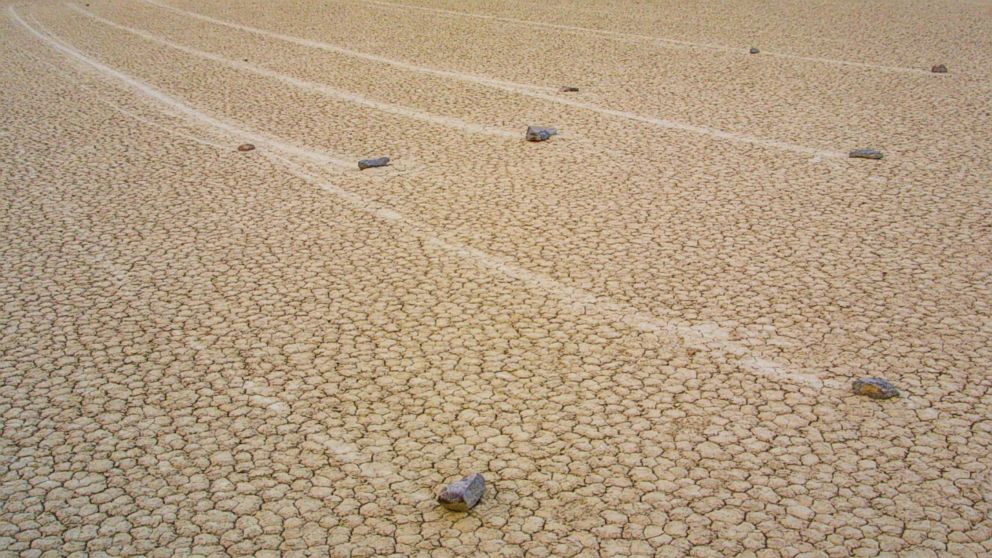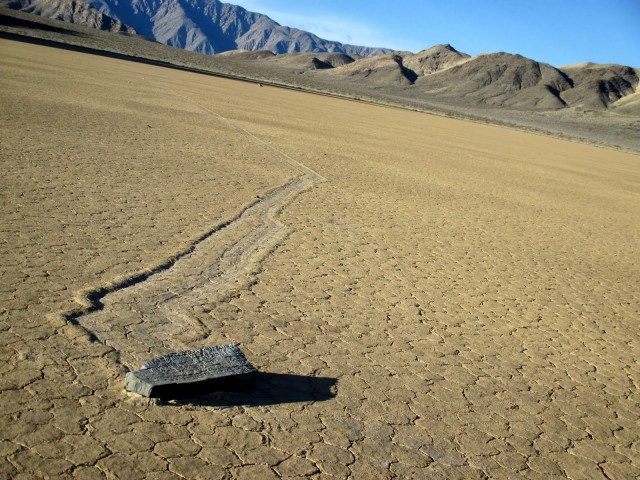It looks like you're using an Ad Blocker.
Please white-list or disable AboveTopSecret.com in your ad-blocking tool.
Thank you.
Some features of ATS will be disabled while you continue to use an ad-blocker.
3
share:

These stones move at night but stay still during the day... or do they? No one has seen them move.
Racetrack Playa is the location of these sailing stones, and for decades, geologists have been trying to figure out what moves them across the sand. One of the first studies published in 1948 suggested they were moved by dust devils, and a more recent study proposed it was hurricane-force winds. However, only the most recent study has found a plausible solution that involves freezing ice.
This quick documentary summarizes the situation in about a minute.
So how is it done?
The Racetrack Playa must first fill with water — deep enough to float massive sheets of ice, yet still shallow enough to leave the rocks exposed. Nighttime temperatures must then get cold enough to freeze the water, forming mammoth-size ice panes — thin enough to glide across the lake bed, yet thick enough to gain momentum and clear the stones in their way.
As the next day’s afternoon sun thaws the ice, these sheets break apart into chunks that, with any luck, a steady wind will propel across the playa pool. When the ice chunks hit the rocks — ranging from pebble to boulder-size pieces weighing up to 200 pounds – the stones are driven across the soft mud below, leaving behind their signature trails.
Source - WP

It must take some force to move the stone this far.
Documentary featuring William Shatner.
I've always wondered why they don't put some cameras out there watching some of the stones with motion detection and some atmospheric equipment and
so forth to monitor conditions. Then, once one of them started to move, the conditions are recorded and the rock is filmed moving visually.
You could just leave the stuff out there for a year with minimal upkeep and wait for results. Wouldn't cost much either. Maybe stick some GPS trackers on them too.
This seems like something that could be solved by now without much work involved and with the video evidence and other data to show what's happening.
You could just leave the stuff out there for a year with minimal upkeep and wait for results. Wouldn't cost much either. Maybe stick some GPS trackers on them too.
This seems like something that could be solved by now without much work involved and with the video evidence and other data to show what's happening.
When the ice chunks hit the rocks — ranging from pebble to boulder-size pieces weighing up to 200 pounds – the stones are driven across the soft mud below, leaving behind their signature trails.
Ok so how come a 200 pound ice chunk doesn't leave "signature trails" too, just the rocks huh
originally posted by: mOjOm
I've always wondered why they don't put some cameras out there watching some of the stones with motion detection and some atmospheric equipment and so forth to monitor conditions. Then, once one of them started to move, the conditions are recorded and the rock is filmed moving visually.
You could just leave the stuff out there for a year with minimal upkeep and wait for results. Wouldn't cost much either. Maybe stick some GPS trackers on them too.
This seems like something that could be solved by now without much work involved and with the video evidence and other data to show what's happening.
Well if you watched the video, you'll see the footage of them moving...
lol
originally posted by: sn0rch
Well if you watched the video, you'll see the footage of them moving...
lol
I watched the first video. The 2 min. one vs. the 45 min. one. Didn't want to wait that long. Why didn't they just put that in the 2 min. version then??? That one just talks about the guy using his freezer to simulate it.
Final Edit. They show a "Simulation" of the stones moving in an experiment using a wind tunnel at around 14min. into the doc for those interested. Still not footage of the Actual Stones moving in a Real World Example, but I'd say it solves it.
edit on 1-9-2014 by mOjOm because: (no reason
given)
Seems like a pretty huge process that for some reason no one in 70 years has been able to observe. This is just a hypothesis?
new topics
-
Happy Thanksgiving to ATS
General Chit Chat: 2 seconds ago -
Simple Thanksgiving
Food and Cooking: 6 hours ago -
Trump could make a peaceful American Revolution
US Political Madness: 9 hours ago -
Trump Presidential Transition Team will not use GSA or Government entities to come to DC
US Political Madness: 10 hours ago -
Mind Blowing Cave under someones land
Fragile Earth: 10 hours ago -
The Party of Peace - Trump Cabinet Picks Targeted with Death Threats
US Political Madness: 11 hours ago
top topics
-
V.P. Kamala Harris releases a video and nobody understands why
US Political Madness: 14 hours ago, 16 flags -
Mind Blowing Cave under someones land
Fragile Earth: 10 hours ago, 16 flags -
The Party of Peace - Trump Cabinet Picks Targeted with Death Threats
US Political Madness: 11 hours ago, 15 flags -
Trump could make a peaceful American Revolution
US Political Madness: 9 hours ago, 14 flags -
Trump Presidential Transition Team will not use GSA or Government entities to come to DC
US Political Madness: 10 hours ago, 13 flags -
Simple Thanksgiving
Food and Cooking: 6 hours ago, 13 flags -
Happy Thanksgiving to ATS
General Chit Chat: 2 seconds ago, 0 flags
active topics
-
Happy Thanksgiving to ATS
General Chit Chat • 0 • : whyamIhere -
Simple Thanksgiving
Food and Cooking • 26 • : Station27 -
Mind Blowing Cave under someones land
Fragile Earth • 16 • : RickyD -
The Party of Peace - Trump Cabinet Picks Targeted with Death Threats
US Political Madness • 27 • : DBCowboy -
President-Elect DONALD TRUMP's 2nd-Term Administration Takes Shape.
Political Ideology • 256 • : WeMustCare -
-@TH3WH17ERABB17- -Q- ---TIME TO SHOW THE WORLD--- -Part- --44--
Dissecting Disinformation • 3389 • : Crazierfox -
Trump Presidential Transition Team will not use GSA or Government entities to come to DC
US Political Madness • 11 • : WeMustCare -
I thought Trump was the existential threat?
World War Three • 113 • : WeMustCare -
Mood Music Part VI
Music • 3719 • : MRTrismegistus -
Tunnels of Terror: The Cryptid Connection The Why Files
Cryptozoology • 5 • : TheMisguidedAngel
3
